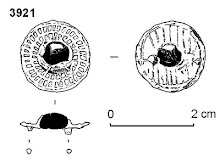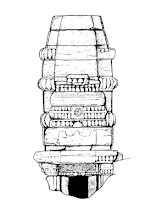A recent watching brief on a new electric supply trench at a
Cotswold church led to the recovery of several fragments of carved medieval masonry,
which have given an insight into the past appearance of the medieval church.
 |
| Reconstruction of medieval architectural fragments |
The fragments were found reused as rubble in the foundation
of a nineteenth century set of steps within the tower. Two of the fragments
were relatively simple mouldings, but a group of five similar fragments were
more complex and warranted a far closer look. Once they had been cleaned up it
was clear that the pieces were from a masonry panel pierced with quatrefoil (four-lobed)
and circular openings; the quatrefoils set within sunken spandrel decoration on
the front, and with a shallow chamfer on the reverse. Also on the reverse faces
were a grid of shallow rebates or channels which had rust marks suggesting iron
bars once had sat in those grooves, perhaps holding the panels in place.
The form of the original design could be reconstructed, and
two of the pieces fit together to form one half of a quatrefoil; interestingly
two quatrefoil designs could be reconstructed, one being set square to its
frame, the other set diagonally, whilst two smaller fragments appeared to be
from simple circular openings.
The design and form reconstructed, the next question was to
establish the original location of the pieces. They were all very weathered on
the main faces, but crisp and sharp on the inner faces indicating they were
exposed to the weather at their original site. They could have been from a decorated
parapet, or from tracery, but if so why the iron bars, and the cross-sections
weren't right for tracery. Looking upwards provided a possible solution, the
Perpendicular tower of the church has its upper windows decorated with pierced
baffles, pierced by quatrefoil and circular openings…
Pierced masonry baffle panels were used on church towers at
the level of the bell-chamber, where along with stone or wooden louvres they
allowed the sound of the bells to ring out. Other examples can be seen locally
at the 15th century tower of St John the Baptist Cirencester and at Holy
Trinity Minchinhampton where blind or louvred panels are pierced by quatrefoils.
The Cirencester example seems very similar in form -although slightly later in
style- with thin masonry blocks used to make up the baffles.
 |
| Baffles with quatrefoil piercings: left is the Victorian replacement, right is St John the Baptist, Cirencester |
The church had been rebuilt -like many Cotswold churches- in
the mid 19th century, and it seems possible that these fragments are from the
original medieval baffles which were replaced with new baffles made up with a
simplified version of the original design. The reuse of the original pieces as rubble
within the steps has fortuitously preserved them, and their rediscovery and
reconstruction indicates the richness of decoration of the medieval church -even
in the places that most medieval parishioners would not normally notice.
Further work is required to check these initial findings and
to complete the reconstruction of the design.














No comments:
Post a Comment